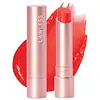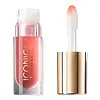Lawless Forget The Filler Lip Plumping Line Smoothing Tinted Balm Stick Versus Iconic London Lustre Lip Oil
What's inside
What's inside
 Key Ingredients
Key Ingredients

 Benefits
Benefits

 Concerns
Concerns

 Ingredients Side-by-side
Ingredients Side-by-side

Dipentaerythrityl Hexahydroxystearate/Hexastearate/Hexarosinate
Skin ConditioningSynthetic Beeswax
Emulsion StabilisingDiisostearyl Malate
EmollientOleic/Linoleic/Linolenic Polyglycerides
EmollientOctyldodecanol
EmollientButyrospermum Parkii Butter
Skin ConditioningSimmondsia Chinensis Seed Oil
EmollientPolyglyceryl-3 Diisostearate
EmulsifyingMicrocrystalline Wax
Emulsion StabilisingHydrogenated Poly(C6-14 Olefin)
EmollientC18-21 Alkane
SolventSimmondsia Chinensis Butter
Skin ConditioningAroma
Ethylhexyl Palmitate
EmollientTocopheryl Nicotinate
AntioxidantJojoba Esters
EmollientMenthoxypropanediol
MaskingHelianthus Annuus Seed Wax
Skin ConditioningTribehenin
EmollientEthylene/Propylene/Styrene Copolymer
Sorbitan Isostearate
EmulsifyingAcacia Decurrens Flower Wax
EmollientPolyglycerin-3
HumectantGlycerin
HumectantWater
Skin ConditioningRosa Canina Fruit Oil
EmollientZingiber Officinale Root Extract
MaskingButylene/Ethylene/Styrene Copolymer
Palmitoyl Tripeptide-1
Skin ConditioningLactic Acid
BufferingPhenoxyethanol
PreservativePentaerythrityl Tetra-Di-T-Butyl Hydroxyhydrocinnamate
AntioxidantTocopherol
AntioxidantCI 73360
Cosmetic ColorantCI 45410
Cosmetic ColorantCI 19140
Cosmetic ColorantDipentaerythrityl Hexahydroxystearate/Hexastearate/Hexarosinate, Synthetic Beeswax, Diisostearyl Malate, Oleic/Linoleic/Linolenic Polyglycerides, Octyldodecanol, Butyrospermum Parkii Butter, Simmondsia Chinensis Seed Oil, Polyglyceryl-3 Diisostearate, Microcrystalline Wax, Hydrogenated Poly(C6-14 Olefin), C18-21 Alkane, Simmondsia Chinensis Butter, Aroma, Ethylhexyl Palmitate, Tocopheryl Nicotinate, Jojoba Esters, Menthoxypropanediol, Helianthus Annuus Seed Wax, Tribehenin, Ethylene/Propylene/Styrene Copolymer, Sorbitan Isostearate, Acacia Decurrens Flower Wax, Polyglycerin-3, Glycerin, Water, Rosa Canina Fruit Oil, Zingiber Officinale Root Extract, Butylene/Ethylene/Styrene Copolymer, Palmitoyl Tripeptide-1, Lactic Acid, Phenoxyethanol, Pentaerythrityl Tetra-Di-T-Butyl Hydroxyhydrocinnamate, Tocopherol, CI 73360, CI 45410, CI 19140
C21-28 Alkane
EmollientDiisostearyl Malate
EmollientHydrogenated Styrene/Isoprene Copolymer
Helianthus Annuus Seed Oil
EmollientEthylhexyl Palmitate
EmollientAroma
Pentaerythrityl Tetra-Di-T-Butyl Hydroxyhydrocinnamate
AntioxidantLauric Acid
CleansingPentylene Glycol
Skin ConditioningCI 19140
Cosmetic ColorantLauryl Alcohol Diphosphonic Acid
Emulsion StabilisingTrihydroxystearin
Skin ConditioningDiethylhexyl Syringylidenemalonate
Skin ProtectingLecithin
EmollientCI 15850
Cosmetic ColorantAlkanna Tinctoria Root Extract
Skin ConditioningTocopherol
AntioxidantCaprylic/Capric Triglyceride
MaskingCI 77491
Cosmetic ColorantCI 77492
Cosmetic ColorantSodium Hyaluronate
HumectantAscorbyl Palmitate
AntioxidantSolanum Lycopersicum Fruit Extract
AntioxidantCitric Acid
BufferingGlucomannan
Skin ConditioningC21-28 Alkane, Diisostearyl Malate, Hydrogenated Styrene/Isoprene Copolymer, Helianthus Annuus Seed Oil, Ethylhexyl Palmitate, Aroma, Pentaerythrityl Tetra-Di-T-Butyl Hydroxyhydrocinnamate, Lauric Acid, Pentylene Glycol, CI 19140, Lauryl Alcohol Diphosphonic Acid, Trihydroxystearin, Diethylhexyl Syringylidenemalonate, Lecithin, CI 15850, Alkanna Tinctoria Root Extract, Tocopherol, Caprylic/Capric Triglyceride, CI 77491, CI 77492, Sodium Hyaluronate, Ascorbyl Palmitate, Solanum Lycopersicum Fruit Extract, Citric Acid, Glucomannan
Ingredients Explained
These ingredients are found in both products.
Ingredients higher up in an ingredient list are typically present in a larger amount.
Aroma refers to an ingredient, or mixture of ingredients, that impart or mask a flavor.
The name is slightly confusing. This is because INCI associates aroma with flavor instead of smell.
Here is the official definition from the The International Cosmetic Ingredient Dictionary and Handbook:
“Aroma is a term for ingredient labeling used to identify that a product contains a material or combination of materials normally added to a cosmetic to produce or to mask a particular flavor.”
INCI shows the only purpose of aroma to be "flavouring".
However, due to regulation differences, some companies may use aroma in place of parfum.
In Canada, this ingredient only has to be listed in concentrations above 1%.
Learn more about AromaCI 19140 is also known as Tartrazine. Tartrazine is a synthetic dye used in cosmetics, foods, and medicine to add a yellow color.
Tartrazine is created from petroleum and is water-soluble.
Some people may experience allergies from this dye, especially asthmatics and those with an aspirin intolerance.
Learn more about CI 19140Diisostearyl Malate is an emollient and most often used in lip products. It comes from isostearyl alcohol, a fatty acid, and malic acid, an AHA.
As an emollient, Diisostearyl Malate helps create a thin film on your skin to trap moisture in. This helps keep your skin soft and smooth.
Ethylhexyl Palmitate, also known as octyl palmitate, is created from 2-ethylhexyl alcohol and palmitic acid. It is a fatty acid ester.
The fatty acid content of Ethylhexyl Palmitate makes it an emollient. Emollients help soften and hydrate your skin by trapping moisture within.
Ethylhexyl Palmitate is also used to help improve the texture of cosmetics. It helps other ingredient dissolve in products and help disperse ingredients more evenly.
You'll likely find this ingredient in sunscreen, as it is often used to mix UV-blocking ingredients such as avobenzone and ethylhexyl triazone.
It can also help stabilize the fragrances in a product as a fragrance fixative.
Ethylhexyl Palmitate can be used to substitute mineral oil.
Due to its high fatty acid content, it may not be fungal-acne safe.
Learn more about Ethylhexyl PalmitatePentaerythrityl Tetra-Di-T-Butyl Hydroxyhydrocinnamate (long name, huh?) is a synthetic antioxidant.
It is used to help stabilize other antioxidants or prevent the color from changing in a product.
As an antioxidant, it helps fight free-radical molecules. Free-radical molecules are capable of damaging our cells and other genetic material. Thus, antioxidants may reduce the signs of aging.
This ingredient is oil-soluble.
Learn more about Pentaerythrityl Tetra-Di-T-Butyl HydroxyhydrocinnamateTocopherol (also known as Vitamin E) is a common antioxidant used to help protect the skin from free-radicals and strengthen the skin barrier. It's also fat soluble - this means our skin is great at absorbing it.
Vitamin E also helps keep your natural skin lipids healthy. Your lipid skin barrier naturally consists of lipids, ceramides, and fatty acids. Vitamin E offers extra protection for your skin’s lipid barrier, keeping your skin healthy and nourished.
Another benefit is a bit of UV protection. Vitamin E helps reduce the damage caused by UVB rays. (It should not replace your sunscreen). Combining it with Vitamin C can decrease sunburned cells and hyperpigmentation after UV exposure.
You might have noticed Vitamin E + C often paired together. This is because it is great at stabilizing Vitamin C. Using the two together helps increase the effectiveness of both ingredients.
There are often claims that Vitamin E can reduce/prevent scarring, but these claims haven't been confirmed by scientific research.
Learn more about Tocopherol